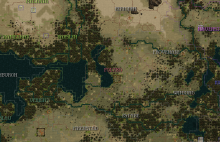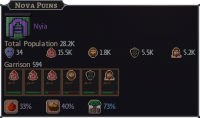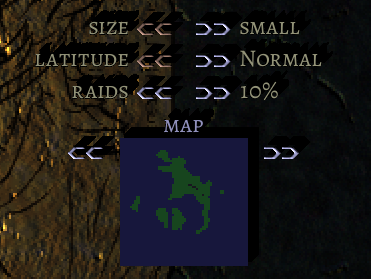World: Difference between revisions
No edit summary |
|||
| Line 30: | Line 30: | ||
Because every single resource will not be easily be within reach of the player's settlement, the player will need to [[Trading|trade]] for some of them. This is done by building an [[export depot]] and [[import depot]]. A trader from another settlement will periodically arrive to the player's settlement and collect resources stored at the export depot, then leave resources of the player's choosing at the import depot. | Because every single resource will not be easily be within reach of the player's settlement, the player will need to [[Trading|trade]] for some of them. This is done by building an [[export depot]] and [[import depot]]. A trader from another settlement will periodically arrive to the player's settlement and collect resources stored at the export depot, then leave resources of the player's choosing at the import depot. | ||
With the use of admin points (again, gained from an administration building), resources and animals can have taxes placed on them, increasing their value, but slightly lowering the loyalty of the population. Resources can also be completely exhausted, which exhausts the supply of resources for up to two years, but then those resources will not be produced for four times the time it took to exhaust them. | |||
[[Category:Gameplay_elements]] | [[Category:Gameplay_elements]] | ||
Revision as of 21:41, 2 July 2021


The world of Songs of Syx is a vast area made up of many settlements, regions, natural resources and huntable wildlife. When starting a new game, the player will be able to choose the location of their settlement, which will also be the capital of it. Depending on how far north, south or anywhere between, there will be a notable climate type that affects gameplay, which controls what pastures, farms and wildlife will be available in gameplay.
A settlement location should be chosen carefully, so that it matches the intended playstyle of the player. Each climate provides bonuses to hunting, farming and fishing, so the player should play to those bonuses and strengths.
The world can be customized before starting the game. Raids will occur once the player's settlement reaches a certain level of development.
Regions

Regions are bordered areas of the world. When starting the game, the player will have a region to themselves where their settlement will be. Other regions contain other settlements, though some may simply be open land. Depending on how the player interacts with other settlements, they may be neutral, allied or hostile to the player. Trading carts and storm clouds can also be seen moving along the world screen.
A cart slowly between regions.
By constructing an administration building, the player can accumulate admin points, which can be spent to upgrade and maintain their settlement. This ranges from adding efficiency to certain categories of buildings to adding taxes to resources.
When hovering the mouse over different regions, such as population, which shows how many citizens of each race is in a settlement, as well as the percent of their population increase via reproduction. Increasing infrastructure and sanitation gives a slight increase to reproduction for some races. The amount of army divisions, farms and mines can also be seen in each region.
Other regions can be interacted with. By default, trading is constantly done between regions. When the player builds at least one export depot and one import depot, the player's settlement can establish trading with others. Other settlements can be attacked and conquered by the player if their military is strong enough.
Climate
- Main article: Climate

There are three types of climates: warm, temperate and cold. Warm and cold climates provide a high chance of temperature-related deaths. Temperate climates have less of a chance of extreme temperatures, but they can still occur, this makes temperate the safest choice for newer players. Clothing can protect against all temperatures.
As mentioned before, some farms and pastures are disabled in specific climates. For example, mushroom farms cannot be built in temperate and warm climates, because the heat of the sun would damage the mushrooms. Different races in the game prefer specific climates, with Cretonians preferring warm climates and Dondorians preferring warm ones. A settlement will get more immigrants based on the climate preference.
Resources
- Main article: Resources
Every location has differing shares of natural resources. When choosing the location of your settlement, an information box will appear to tell you the availability and abundance of natural resources: clay, coal, gems, ore, sithilon ore and stone. Other natural elements of the world are shown to the player, such as the amount of water, mountains, and trees.
Obviously, the player should choose a location that has as many resources as possible, although it's borderline impossible to get a high amount of ALL resources, so the player should try to find the closest to having everything in one location. Wood (a heavily forested area), stone and water are among the most important things to have near a settlement, as wood and stone are extremely common building materials, and water is needed for fishing and relaxing in (especially in hot weather).
Because every single resource will not be easily be within reach of the player's settlement, the player will need to trade for some of them. This is done by building an export depot and import depot. A trader from another settlement will periodically arrive to the player's settlement and collect resources stored at the export depot, then leave resources of the player's choosing at the import depot.
With the use of admin points (again, gained from an administration building), resources and animals can have taxes placed on them, increasing their value, but slightly lowering the loyalty of the population. Resources can also be completely exhausted, which exhausts the supply of resources for up to two years, but then those resources will not be produced for four times the time it took to exhaust them.

